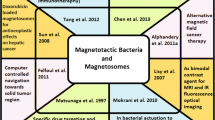Abstract
Magnetosomes are nanoparticles coated with organic membrane produced by magnetotactic bacteria. They appear to be a suitable carrier for the targeted drug transport, which represents a new method of cancer treatment. Advantages of targeted drugs transport are the minimizing of hurt to the organism, specific focusing on certain types of tissues, increased effect of the drug, reduced drug dose and hence side effects. The main goal of the present study was to verify the effect of bacterial magnetic nanoparticles produced by Magnetospirillum strain AMB-1 on cancer cell proliferation, plasmatic membrane integrity, induction of apoptosis as well as on the expression of Bcl-2 in the human lung cancer cell line A549. Obtained results showed that magnetosomes did not have a significant effect on proliferation activity of cells but affected their viability. Moreover, they affected structural integrity of plasmatic membrane and induced apoptosis in cancer cells after their incorporation. The expression of Bcl-2 was also significantly reduced. Taking all these data together, it can be emphasized that magnetosomes severely induce apoptosis in lung cancer cells and after performing the further experiments they could be used in different biomedical applications.
Similar content being viewed by others
References
Akbarzadeh A., Samiei M. & Davaran S. 2012. Magnetic nanoparticles: preparation, physical properties, and applications in biomedicine. Nanoscale Res. Lett. 7: 144. DOI: https://doi.org/10.1186/1556-276X-7-144
Alphandéry E., Guyot F. & Chebbi I. 2012. Preparation of chains of magnetosomes, isolated from Magnetospirillum, magneticum strain AMB-1 magnetotactic bacteria, yielding efficient treatment of tumors using magnetic hyperthermia. Int. J. Pharm. 434: 444–452. DOI:https://doi.org/10.1016/j.ijpharm.2012.06.015
Bazylinski D.A. & Schübbe S. 2007. Controlled biomineralization by and applications of magnetotactic bacteria. Adv. Appl. Microbiol. 62: 21–62. DOI: https://doi.org/10.1016/S0065-2164(07)62002-4
Estelrich J., Sánchez-Martín M.J. & Busquets M.A. 2015. Nanoparticles in magnetic resonance imaging: from simple to dual contrast agents. Int. J. Nanomed. 10: 1727–1741. DOI: https://doi.org/10.2147/IJN.S76501
Hashim A., Molcan M., Kovac J., Varchulová Z., Gojzewski H., Makowski M., Kopcansky P., Tomori Z. & Timko M. 2012. The influence of morphology on magnetic properties of magnetosomes. Acta Physica Polonica A 121: 1250–1252. DOI: https://doi.org/10.12693/APhysPo1A.121.1250
Lei H., Li S.Y., Yong Y., Zhao F.M., Jie H. & Jin C. 2008. Research on the structure and performance of bacterial magnetic nanoparticles. J. Biomater. Appl. 22: 433–448. DOI: https://doi.org/10.1177/0885328207079064
Mannucci S., Ghin L., Conti G., Tambalo S., Lascialfari A., Orlando T., Benati D., Bernardi P., Betterle N., Bassi R., Mar-zola P. & Sbarbati A. 2014. Magnetic nanoparticles from Magnetospirillum gryphiswaldense increase the efficacy of thermotherapy in a model of colon carcinoma. PLoS One 9: e108959. DOI: https://doi.org/10.1371/journal.pone.0108959
Matsunaga T., Okamura Y., Fukuda Y., Wahyudi A.T., Murase Y. & Takeyama H. 2005. Complete genome sequence of the facultative anaerobic magnetotactic bacterium Magnetospirillum sp. strain AMB-1. DNA Res. 12: 157–166. DOI: https://doi.org/10.1093/dnares/dsi002
Schleifer K.H., Schuler D., Spring S., Wiezenegger M., Amann R., Ludwig W. & Kohler M. 1991. The genus Magnetospirillum gen. nov. description of Magnetospirillum gryphiswaldense sp. nov. and transfer of Aquaspirillum magnetotacticum to Magnetospirillum magnetotacticum comb. nov. Syst. Appl. Microbiol. 14: 379–385. DOI: https://doi.org/10.1016/S0723-2020(11)80313-9
Singh D., McMillan J.M., Kabanov A.V., Sokolsky-Papkov M. & Gendelman H.E. 2014. Bench-to-bedside translation of magnetic nanoparticles. Nanomedicine (Lond.) 9: 501–516. DOI: https://doi.org/10.2217/NMM.14.5.
Sun J., Li Y., Liang X.J. & Wang P.C. 2011. Bacterial magnetosome: A novel biogenetic magnetic targeted drug carrier with potential multifunctions. J. Nanomater. 2011: Article ID 469031, 13 pp. DOI: https://doi.org/10.1155/2011/469031
Sun J.B., Duan J.H., Dai S.L., Ren J., Guo L., Jiang W. & Li, Y. 2008. Preparation and anti-tumor efficiency evaluation of doxorubicin-loaded bacterial magnetosomes: magnetic nanoparticles as drug carriers isolated from Magnetospirillum gryphiswaldense. Biotechnol. Bioeng. 101: 1313–1320. DOI: https://doi.org/10.1002/bit.22011
Sun J.B., Wang Z.L., Duan J.H., Ren J., Yang X.D., Dai S.L. & Li Y. 2009. Targeted distribution of bacterial magnetosomes isolated from Magnetospirillum gryphiswaldense MSR-1 in healthy Sprague-Dawley rats. J. Nanosci. Nanotechnol. 9: 1881–1885. DOI: https://doi.org/10.1166/jnn.2009.410
Taoka A., Asada R., Sasaki H., Anzawa K., Wu L.F. & Fuku-mori Y. 2006. Spatial localizations of Mam22 and Maml2 in the magnetosomes of Magnetospirillum magnetotacticum. J. Bacteriol. 188: 3805–3812. DOI: https://doi.org/10.1128/JB.00020-06
Wark P.A. & Peto J. 2008. Cancer epidemiology, pp. 278–286. In: Killewo J. (ed.), Epidemiology and Demography in Public Health, Academic Press, Amsterdam, 512 pp. ISBN: 978-0-12-382200-0
Zhang X.D., Wang Y., Wu J.C., Lin F., Han R., Han F., Fukunaga K. & Qin Z.H., 2009. Down-regulation of Bcl-2 enhances au-tophagy activation and cell death induced by mitochondrial dysfunction in rat striatum. J. Neurosci. Res. 87: 3600–3610. DOI: https://doi.org/10.1002/jnr.22152.
Author information
Authors and Affiliations
Corresponding author
Rights and permissions
About this article
Cite this article
Varchulova Novakova, Z., Gasparova, I., Krajciova, L. et al. Effect of magnetosomes on cell proliferation, apoptosis induction and expression of Bcl-2 in the human lung cancer cell line A549. Biologia 72, 554–560 (2017). https://doi.org/10.1515/biolog-2017-0059
Received:
Accepted:
Published:
Issue Date:
DOI: https://doi.org/10.1515/biolog-2017-0059




